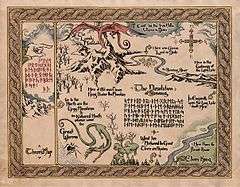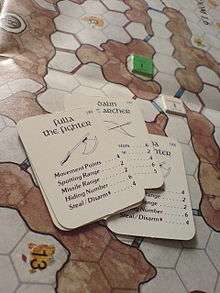Lonely Mountain
| Lonely Mountain | |
|---|---|
 Artist's depiction of the Lonely Mountain | |
 Thrór's map of the Lonely Mountain | |
| J. R. R. Tolkien's legendarium location | |
| Other name(s) | Erebor; the Kingdom under the Mountain |
| Type | isolated mountain |
| Ruler | Kings of Durin's Folk: [1] T.A. 1999-c.2200, [2] 2590-2770, [3] 2941-Fourth Age; Smaug T.A. 2770-2941 |
| Notable locations | the Chamber of Thrór, Dale, the Front Gate, the Great Hall, Ravenhill, the secret door |
| Location | Northeast of Mirkwood |
| Founder | Thráin I |
In J. R. R. Tolkien's Middle-earth legendarium, the Lonely Mountain is a mountain in the north of Wilderland. It is the source of the Celduin River, and the location of the Kingdom under the Mountain. The town of Dale lies in a vale on its southern slopes.
The mountain is called Erebor in Sindarin (one of the languages devised by Tolkien). This name, a translation of "Lonely Mountain", does not appear in The Hobbit, where the mountain is called by the English name throughout, or simply the Mountain. In The Lord of the Rings, the name "Erebor" occurs only once in the main narrative text: in chapter 9, book V of The Return of the King ("The Last Debate"); it is also found once in the Prologue, in the summary of The Hobbit.
The Lonely Mountain is the goal of the protagonists in The Hobbit, and the scene of the climax. The story of The Hobbit is sometimes referred to as the Quest of Erebor.
Internal history
Natural history
Erebor stood hundreds of miles from the nearest mountain range. Tolkien's rendering of Thrór's map in The Hobbit shows the mountain with six ridges stretching out from a central peak that was snowcapped well into spring. The whole mountain was perhaps ten miles in diameter; it contained fabulous lodes of gold and jewels.[1]
The mountain was the habitat for a variety of plants and animals, including thrushes, crows, snails and pines; some of these were endemic sub-species. Perhaps the most well-known were the ravens of Ravenhill, a spur of the mountain. Some wildlife survived the Desolation of Smaug,[2] a dragon who invaded the Mountain and dominated its surrounds for nearly 200 years in the Third Age.
Origins of the Kingdom under the Mountain
Erebor became the home of the Folk of Durin, a clan of Dwarves known as the Longbeards, after they were driven from their ancestral home of Khazad-dûm. In the latter days of the Third Age, this Kingdom under the Mountain held one of the largest dwarvish treasure hoards in Middle-earth.
Dale, a town of Men built between the two southern spurs of Erebor,[3] formed an economically symbiotic relationship with the dwarves.
The Kingdom under the Mountain was founded by Thráin I the Old, who discovered the Arkenstone there. His son, Thorin I, left the mountain with much of the Folk of Durin to live in the Ered Mithrin (Grey Mountains) on account of the great riches to be found in that range. After dragons plundered their hoards, the Longbeards, led now by Thrór, a descendant of Thorin, returned to Erebor to take up the title King under the Mountain. Under Thrór's reign, Erebor became a great stronghold where the dwarves became a numerous and prosperous people. The Dwarves of Erebor were at that time well known for the making of matchless weapons and armour, and there was great demand for their work by the surrounding peoples. The Longbeards amassed a large treasure hoard during this time.
Erebor in The Hobbit
In 2770 T.A., while the young Thorin II Oakenshield was out hunting, the dragon Smaug flew south from the Grey Mountains, killed all the dwarves he could find, and destroyed the town of Dale. Smaug then took over the mountain, using the dwarves' hoard as a bed. King Thrór, his son Thráin II, and several companions escaped death by a secret door. Although Thrór and Thráin later perished, Thorin lived in exile in the Ered Luin until, by chance, he met the wizard Gandalf. Together they formed a plan to reclaim the mountain. Gandalf insisted that burglary was the best approach and recommended the hobbit Bilbo Baggins, whom he represented to be a professional thief.
The Quest of Erebor
Thus Bilbo, Thorin, and Thorin's company of twelve other Dwarves travelled to the Lonely Mountain to regain the treasure. They planned to use the secret door, whose key Gandalf had managed to obtain from Thráin, whom he had found at the point of death in the pits of Dol Guldur. On Durin's Day, when the setting sun and the last moon of autumn were in the sky together, the day's last sunlight would fall on the door and expose its keyhole so that it could be unlocked. By a fortunate coincidence, this happened soon after Bilbo and the dwarves arrived, and the hobbit was able to enter the mountain and steal a golden cup.
Smaug, enraged by the theft, emerged from the mountain and flew south to destroy Lake-town, which he thought to be the source of the "thieves". During this attack Smaug was slain by Bard the Bowman; Thorin claimed the mountain on learning of Smaug's demise. However, the Men of Esgaroth, supported by Thranduil and the Elves of Mirkwood, marched in force to the mountain to demand a part of the dragon's hoard as recompense for the destruction. Thorin, mad with greed, refused all claims and sent word to his second cousin Dáin II Ironfoot, chief of the Dwarves of the Iron Hills, who brought reinforcements to the aid of Thorin and Company. However before any battle began, an army of Orcs and Wargs descended on Erebor. Dwarves, Elves, and Men joined ranks against them, which led to the Battle of Five Armies. During this battle, Thorin's nephews Fíli and Kíli were slain, and Thorin himself was mortally injured and died shortly afterwards. The title of King under the Mountain passed to Dáin.
Erebor in The Lord of the Rings
With the restoration of the Kingdom under the Mountain the area became prosperous again. Dale was rebuilt under Bard's leadership, and Dwarves and Men reforged their friendship.
Some of the Dwarves, led by Balin, left Erebor to reclaim the ancient Dwarvish Kingdom of Khazad-dûm (also known as Moria). They established a colony there but five years later Balin was killed by an Orc, and soon after Moria was overrun by Orcs and the rest of the Dwarves were killed.
Gimli, a dwarf of Erebor and the son of Glóin, one of Thorin's twelve companions, was chosen to represent his people in the Fellowship of the Ring and helped Aragorn II regain the throne of Gondor.
In the War of the Ring, an emissary from Sauron, the lord of Mordor, twice came to Erebor and spoke to Dáin Ironfoot, who was still King under the Mountain. The messenger asked for assistance in finding the One Ring, and in return offered Moria and three of the seven Dwarf rings to Dáin, but he refused. Sauron's northern army, which included many Easterlings, then attacked; Dale was overrun, and many Dwarves and Men took refuge in Erebor, which was promptly surrounded. Dáin was killed before the gates of Erebor defending the body of his fallen ally King Brand of Dale. Dáin was succeeded by his son Thorin III Stonehelm, who along with King Bard II withstood the siege and later routed Sauron's forces. In The Quest of Erebor, Gandalf related that although Sauron's main thrust was directed against Gondor, the restoration of the Kingdom under the Mountain had established a bulwark against Sauron's northern allies, who otherwise could have done great harm in Arnor and the Shire.
Adaptations

The Lonely Mountain: Lair of Smaug the Dragon is a board game produced in 1985 by Iron Crown Enterprises,[4] designed by Coleman Charlton, which features groups of adventurers, either Dwarves, Elves, Orcs or Men entering Smaug's Lair to capture his treasure before he awakens.
"Erebor", specifically the southern spurs of the Mountain and Dale, is a playable map in The Lord of the Rings: The Battle for Middle-earth II. It has three gates, including the one Tolkien described and two which cannot be closed, to allow those playing as invading forces to easily enter the stronghold.
The Lonely Mountain appears in the Peter Jackson motion-picture adaptations of The Hobbit: An Unexpected Journey, The Desolation of Smaug, and The Battle of the Five Armies.
Namesakes
The International Astronomical Union names all mountains on Saturn's moon Titan after mountains in Tolkien's work.[5] In 2012, they named a Titanean mountain "Erebor Mons" after the Lonely Mountain.[6]
See also
![]()
References
- ↑ Tolkien, J. R. R., The Hobbit, 4th edition, George Allen & Unwin 1978, ch.I p.28; ISBN 0-04-823147-9
- ↑ Tolkien, J. R. R., The Hobbit, 4th edition, George Allen & Unwin 1978, ch.XIII p.208; ISBN 0-04-823147-9
- ↑ Fonstad, Karen Wynn. The Atlas of Middle-earth (Revised Edition) . Houghton Mifflin Company. New York. 1991. pp. 110-1
- ↑ Newsboard, Fellowship Follows, White Dwarf (magazine) #57, September, 1984 p45
- ↑ International Astronomical Union. "Categories for Naming Features on Planets and Satellites". Gazetteer of Planetary Nomenclature. Accessed Nov 14, 2012.
- ↑ International Astronomical Union. "Erebor Mons". Gazetteer of Planetary Nomenclature. Accessed Nov 14, 2012.
External links
- Harper, Amelia (2006). "Lonely Mountain (Erebor)". In Drout, Michael D. C. J. R. R. Tolkien Encyclopedia: Scholarship and Critical Assessment. Routledge. pp. 384–385. ISBN 0-415-96942-5.
- Erebor (Lonely Mountain) at the Encyclopedia of Arda